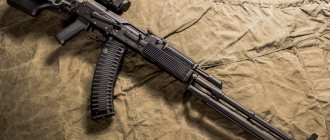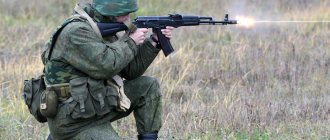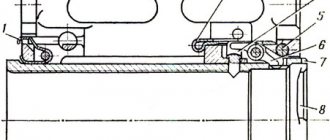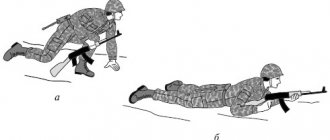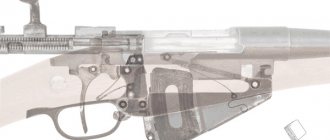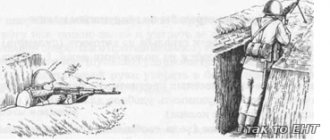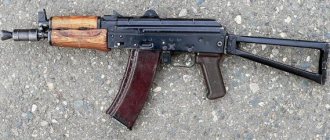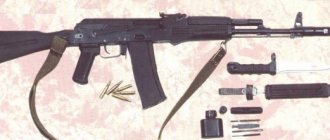History of creation
After the Second World War, using the experience of using the MG34 and MG42 as a basis, the GAU in 1946 developed technical specifications for the design of a domestic single machine gun.
More than 20 samples from various developers were nominated for the competition. The leaders were G.I. Nikitin and V.A. Degtyarev.
But the untimely death of V. Degtyarev allowed G. Nikitin to send a small batch of his PNs for military trials. PN did not pass the exam. The machine gun parts wore out unacceptably quickly, and the automation failed when water got into it.
Later than everyone else, M. T. Kalashnikov began to develop new weapons with his designers V. V. Krupin, V. N. Pushchin, A. D. Kryakushin and others at the Izhevsk Machine-Building Plant.
Working in emergency mode, they were able, having passed evaluation tests in 1959, to win competitive tests in 1960.
It is worth noting that weapon designers were faced with a huge number of practically unsolvable problems. Starting from the use of the already outdated 7.62x54R welt cartridge at that time, and the requirements of the technical specifications in terms of the reliability of weapon automation.
Kalashnikov was helped to achieve such results both by the use of technical solutions that had proven themselves in the creation of AKs, and by the following factors:
- Increased gaps between moving parts of weapon automation;
- Application of non-loose metal tape;
- Use of an adjustable gas outlet unit;
- Maximum unification with weapons in service;
- The maximum possible use of cold stamping under these conditions and the reduction of milling and planing operations.
As a result, it was the machine gun sample presented to the commission by M.T. Kalashnikov passed military tests and entered the army.
The PK (6P6) and PKS (6P3) machine guns were put into service on October 20 and December 28, 1961, respectively; at that time it was an easel machine gun on a tripod machine designed by Samozhenkov, with the ability to work with a bipod.
The tripod had the ability to conduct anti-aircraft fire.
To transport the PKS, a crew of two people was enough. The first number carried the body of the machine gun and additional boxes of cartridges, the second number carried the assembled machine and two 200 cartridge boxes.
The production of weapons was entrusted to the machine-building plant in Kovrov.
Modernization of the PC in 1969 led to a reduction in weight by 1.5 kg and lower production costs; some operations were replaced by stamping and casting, abandoning precision machining.
The Stepanov system machine that replaced the earlier one was also several kilograms lighter.
The repeated competition left no chance for G. Nikitin’s completely revised PN. The Kalashnikov machine gun came into service again. But with the addition of the letter M (modernized)
Content
- 1 Construction details 1.1 Operating mechanism
- 1.2 Features 1.2.1 Attractions
- 1.2.2 Accessories
- 2.1 RPK 2.1.1 RPKS
- 2.2.1 RPKS-74
- 3.1 RPK-16
- 4.1 Former users
TTX PKM
PKM (modernized Kalashnikov machine gun) has the following tactical and technical characteristics:
| Caliber | 7.62 mm |
| Rate of fire | 600 to 700 shots/min |
| Initial bullet speed | 825 m/sec |
| Tape capacity | 100 or 200 or 250 rounds |
| Height of the line of fire on the bipod | 300 mm |
| Cartridge | 7.62×54R |
| Dimensions | 1160×215×372 mm |
| Weight | 7.5 kg |
| Withstands two spare barrels | 25000 shots |
| Sighting range | 1500 meters |
| Replacing a heated barrel | 400 – 500 shots |
The PKM has a rod attached to the machine for firing at airplanes and helicopters. The sights are open type and easily adjustable.
Shooting can only be done in bursts.
Cartridges for PKM have different purposes. Ordinary bullets with a steel core (LPS) are used to fire at enemy personnel.
Target designation and adjustment of fire are achieved using tracer ammunition (T-46), while armor-piercing incendiary ammunition (B-32) is used to hit targets behind cover, ignite fuel and lubricants, and fire at weakly armored targets.
RPK - RPK
The RPK
(
Ruchnoy Pulemyot Kalashnikova
, Russian: RPK Ruchnoy Pemet Kalashnikov or "Kalashnikov manual machine gun") is a 7.62×39mm machine gun of Soviet design, developed by Mikhail Kalashnikov in the early 1960s, in parallel with the AKM assault rifle. It was created as part of a program designed to standardize the Soviet Army's small arms inventory, where it replaced the 7.62×39mm RPD light machine gun. The RPK continues to be used by militaries in the former Soviet Union and some African and Asian countries. RPK is also produced in Bulgaria, Romania and Serbia.
PKM modifications
- PKM, company machine gun;
- PKMN – model equipped with a dovetail strap for mounting night sights or optics;
- PKMS - supplied to the troops with the Stepanov universal machine;
- PKTM is a tank modification of the machine gun, characterized by a reinforced barrel and the presence of an electric trigger;
- PKMB - an analogue of the easel version, but with a swivel for mounting on board an armored personnel carrier of the BTR-60 type of various modifications;
- AEK-999 “Badger” - an improved version of the PC for use in special forces units;
- PKP "Pecheneg", a machine gun created on the basis of a PC intended to replace it in the army, is distinguished by its lightweight design and barrel design with an active radiator;
- Type 80;
- Zastava M84.
AEK-999 "Badger" is manufactured in Kovrov with a non-replaceable barrel from steels used in aviation. The kit includes a low-noise shooting device.
It allows you to make machine gun fire inaudible at a distance of 400-600 meters. The barrel can withstand up to 40,000 shots.
For the Pecheneg, TsNIITochmash created a barrel with forced cooling. Otherwise identical to PKM.
Type 80 is the Chinese version of the PKM. It remained in service with the Chinese army for only three years and was then replaced by the Type 86.
Zastava M84 is a Serbian licensed version of the PKM. The only difference is the butt, which is made without cutouts.
The machine gun crew consists of two people. The PCM kit includes:
- Device for stuffing tapes;
- Spare barrel;
- 2 boxes with tape for 100 rounds;
- 2 boxes with tape for 200 rounds;
- Additional equipment with a night sight is possible.
In 2013, the Kalashnikov concern decided to begin developing a new man-portable six-barreled Kalashnikov machine gun. D. Rogozin suggested the name “Autogen” for it, because the density of fire from it would allow cutting metal sheets.
The work stalled already at the stage of making the model.
The prototype tests planned for 2016 did not take place. Apparently, further developments had to be abandoned for several reasons:
- Multi-barreled machine guns have insufficient firing accuracy;
- Strong recoil;
- The weight of the product is too heavy;
- High energy intensity;
- Weak penetration of 7.62 caliber cartridges;
- Difficulty in developing a mechanism for reloading and feeding cartridges;
- The Vladimirov machine gun (KPV) turned out to be better in all respects.
MMG RPK-74 Kalashnikov Light Machine Gun
- Send to a friend
- Increase
The model of the RPK-74 light machine gun is equipped with a folding bipod and a movable bolt frame. It has a working trigger mechanism, a deactivated detachable magazine for 45 rounds, that is, everything is as close as possible to a combat RPK, the main difference is that it does not fire . Everything else is identical to the real thing, which makes the MMG RPK-74M an excellent gift for people interested in weapons.
- In the same category
- MMG Pistol.
- MMG rifle.
- Layout.
- MMG Automatic.
- MMG machine gun.
- MMG.
- About the product
MMG of the RPK-74 light machine gun . This machine gun was created based on the design of the Kalashnikov assault rifle and is a modernization of the RPK-74 machine gun of 5.45 mm caliber. The modernization consisted of strengthening the receiver, changing the design of the barrel, which increased its service life, introducing a folding plastic stock that was more convenient for transportation, and the presence on all samples of a universal rail for a side bracket for night or day optics.
Combat use of PCs
Vietnam became the first country where PCs were used in real combat. Since then, this reliable and powerful weapon has been used by opposing sides in all wars and conflicts.
This is the civil war in Cambodia, and the Iran-Iraq, and both Afghan, and both Chechen, and Yugoslav wars. It was actively used in military clashes in the post-Soviet space and was even converted from a tank to an infantry version.
PCs in various modifications began to be produced in twelve countries around the world, and used in more than sixty. It was noticed that the military of Western countries also often used this trouble-free machine gun, and in Israel it is even in limited service.
Derivatives
RPK-16
The RPK-16 command automatic weapon of 5.45x39 mm caliber is a further modernization of the RPK-74. It is expected to take over the role of the RPK-74 in the Russian military. It is based on the traditional design and design of the Kalashnikov assault rifle, and also has several new technical and ergonomic features borrowed from the AK-12 program.
The RPK-16 is chambered in 5.45×39mm and uses a removable bipod on a Picatinny rail instead of the fixed bipod of the RPK-74. It has a traditional Kalashnikov long-stroke gas piston system, a removable suppressor, a Picatinny rail on the top of the receiver for mounting various optics/sights and on the bottom of the handguard for mounting a bipod, an ergonomic pistol grip and folding stock and two main barrels along the length; a 550 mm (21.7 in) long barrel (when used or configured for the light machine gun role) and a 370 mm (14.6 in) short barrel (when used or configured for the assault rifle role). Its design allows for replaceable barrels that are easily removed. It has a combat weight of 6 kg (13.23 lb), an overall length of 1,076 mm (42.4 in), a cyclic rate of fire of 700 rounds per minute (rpm), a firing range of 800 m (870 yd) and uses a standard drum magazine at 96 rounds. Also compatible with AK-74 and RPK-74 magazines.
Hammer Boar
A series of semi-automatic rifles and shotguns based on the heavy RPK receiver are produced in Vyatskie Polyany, Russia. These rifles are known as Vepr
(
Boar
> "Wild Boar"). Available in several designs, including:. 223 Remington, 7.62×39mm, 5.45×39mm, 6.5mm Grendel, 7.62×54mmR, .308 Winchester, .30-06 Springfield and Vepr, 12, 20 and .410 gauges. A distinctive feature of the Vepr rifles is the heavy receiver and RPK barrel. The barrel, gas block and bore are fully chrome plated. They are intended for the civilian market and are sold as high-quality hunting rifles. Because of this designation, they lack the features found on most AK-style rifles. Vepr rifles do not have a bayonet lug, built-in cleaning rods or tool kits, do not accept standard AK magazines, and have wooden stocks with thumbholes. Some buy these rifles to "convert" into a traditional-style AK by installing new pistol grip stocks and adding tactical accessories.
Early generations of the Vepr rifle were produced with a slanted receiver, making them incompatible with most AK furniture without a converter. In the second generation, receivers were replaced with straight ones. Subsequent versions of the rifle returned to the canted design. Due to such a rapid change in design, it is not uncommon to find second-generation Vepr rifles with a rough, incomplete stock that has not been sanded or painted.
Prospects for further modernization of PCM
Most information about the development of a new machine gun based on PKM and Pecheneg is classified. However, it became known that the designers of the Degtyarev arms factory focused on reducing the weight and dimensions of the machine gun and improving its ergonomics.
Based on the technical specifications of the Ministry of Defense of the Russian Federation, the product was brought to serial production within 4 years.
For the first time, titanium was used to make machine gun parts.
The barrel was made with ribs and forced cooling, but without a casing. To be able to use the 1P89-3 optical sight, a Picatinny rail was installed.
The buttstock became folding and telescopic. Added tactical grip.
For the needs of special forces, the barrel was shortened and equipped with an attachment for silent and flameless shooting. Under the name "Badger" it received the highest praise from the fighters of these units.
The bipod of the new product can be easily removed and can be mounted on the end of the barrel or on the gas chamber.
Testing of new samples was carried out in special chambers simulating different climatic conditions. Reliability is guaranteed in the temperature range from -50° to +50°. Tests with increased charge and increased pressure are also used.
Accuracy parameters are checked only with single shots.
When delivering large quantities, one randomly selected product from the batch is subjected to comprehensive testing.
As journalists found out, the plant’s design bureau is now engaged in establishing the production of machine guns for local conflicts, and in parallel, the construction of robotic combat systems, such as, for example, Nerekhta, is underway.
Derivatives
RPK-16
The RPK-16 command automatic weapon of 5.45x39 mm caliber is a further modernization of the RPK-74. It is expected to take over the role of the RPK-74 in the Russian military. It is based on the traditional design and design of the Kalashnikov assault rifle, and also has several new technical and ergonomic features borrowed from the AK-12 program.
The RPK-16 is chambered in 5.45×39mm and uses a removable bipod on a Picatinny rail instead of the fixed bipod of the RPK-74. It has a traditional Kalashnikov long-stroke gas piston system, a removable suppressor, a Picatinny rail on the top of the receiver for mounting various optics/sights and on the bottom of the handguard for mounting a bipod, an ergonomic pistol grip and folding stock and two main barrels along the length; a 550 mm (21.7 in) long barrel (when used or configured for the light machine gun role) and a 370 mm (14.6 in) short barrel (when used or configured for the assault rifle role). Its design allows for replaceable barrels that are easily removed. It has a combat weight of 6 kg (13.23 lb), an overall length of 1,076 mm (42.4 in), a cyclic rate of fire of 700 rounds per minute (rpm), a firing range of 800 m (870 yd) and uses a standard drum magazine at 96 rounds. Also compatible with AK-74 and RPK-74 magazines.
Obtaining a weapons permit
To legally purchase a PKM machine gun in Russia, there is a hunting version - PKM-O. To obtain permission you must:
- undergo a medical examination and receive a certificate using special form 046-1;
- pay the state fee;
- have with you a photo 3x4 2 pcs.;
- copy of passport;
- statement;
- certificate of completion of training courses on weapons ownership and passing an exam.
A package of documents is submitted to the police department at the place of registration, and a hunting license is issued.
It is also possible to purchase an airsoft version of the machine gun.
Contest
As usual, experienced Soviet gunsmiths who had gone through the war and, perhaps, the best in the world, took part in the announced competition. Izhevsk residents, led by the legendary Mikhail Kalashnikov, also decided to test their strength and joined the competition, and were the very last of all. Garanin proposed his options, followed by Silin and Pererushev, and Shilin and Gryazev-Lyubimov-Kastornov machine guns were considered. The obvious favorite in this race was the Nikitin-Sokolov option. But all these projects were actively proposed until the Izhevsk residents with their PCs intervened in the competition.
Soviet soldier with PKM in Afghanistan
The PC was presented later than the other participants in the competition and, traditionally for Kalashnikov, won thanks to its simple and, most importantly, reliable design. After being immersed in the water, the PC habitually began to fire in bursts, but his competitor, another finalist presented by Nikitin and Sokolov, could not. And so the matter was resolved. After long tests that were carried out since the post-war 1947, in 1961 the first domestic single machine gun PK (GRAU 6P6 index) finally appeared in the army.
Advantages and disadvantages of the model
Lighter weight and easier to operate and manufacture
Robust and reliable design of the implement
Ability to use standard ammunition belt
Parts and elements are more durable
Significantly reduced carbon deposits and easier cleaning
Disassembly of this model is simpler and easier
Adjustable locking assembly allows for easier barrel replacement
Ammunition is currently outdated
Not high enough rate of fire
The barrel overheats quickly
Contest
As usual, experienced Soviet gunsmiths who had gone through the war and, perhaps, the best in the world, took part in the announced competition. Izhevsk residents, led by the legendary Mikhail Kalashnikov, also decided to test their strength and joined the competition, and were the very last of all. Garanin proposed his options, followed by Silin and Pererushev, and Shilin and Gryazev-Lyubimov-Kastornov machine guns were considered. The obvious favorite in this race was the Nikitin-Sokolov option. But all these projects were actively proposed until the Izhevsk residents with their PCs intervened in the competition.
